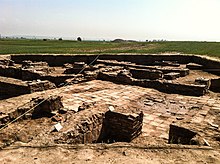| |
 The ruins of Gundeshapur | |
| Alternative name | Weh-Antiyok-Shapur |
|---|---|
| Location | Khuzestan Province, Iran |
| Region | Iranian plateau |
| Coordinates | 32°17′N 48°31′E / 32.283°N 48.517°E |
| Type | Settlement |
| Part of | Sasanian Empire |
| History | |
| Founded | 3rd-century CE |
| Periods | Late antiquity to Middle Ages |
| Cultures | Iranian, Aramaic, Greco-Roman |
| Site notes | |
| Condition | Ruined |
Gundeshapur (Middle Persian: 𐭥𐭧𐭩𐭠𐭭𐭣𐭩𐭥𐭪𐭱𐭧𐭯𐭥𐭧𐭥𐭩, Weh-Andiōk-Ŝābuhr; New Persian: گندیشاپور, Gondēshāpūr) was the intellectual centre of the Sassanid Empire and the home of the Academy of Gundeshapur, founded by Sassanid Emperor Shapur I. Gundeshapur was home to a teaching hospital and had a library and a centre of higher learning. It has been identified with extensive ruins south of Shahabad, a village 14 km south-east of Dezful, to the road for Shushtar, in the present-day province of Khuzestan, southwest Iran.
The town fell into decline after the Islamic conquest of Persia, the city surrendering in 638. However, it continued to remain an important centre in the Islamic period. Ya'qub ibn al-Layth al-Saffar, the founder of the Saffarid dynasty, made Gundeshapur his residence three years before his sudden death in 879. His tomb became one of the most prominent sites in the city.[1]
- ^ Alireza Shapour Shahbazi; Lutz Richter-Bernburg. GONDĒŠĀPUR.
{{cite book}}:|work=ignored (help)
